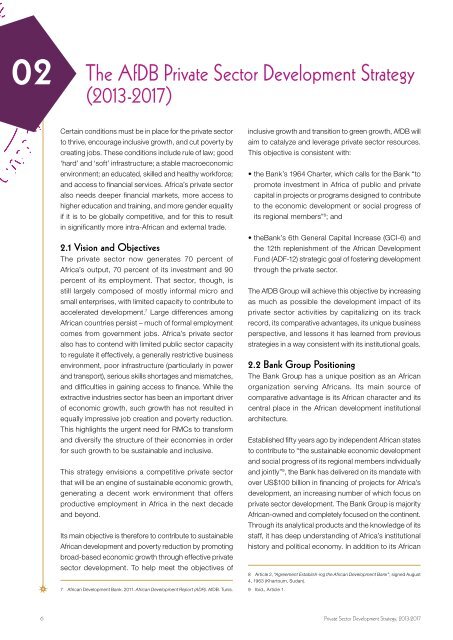2013-2017_-_Private_Sector_Development_Strategy
2013-2017_-_Private_Sector_Development_Strategy
2013-2017_-_Private_Sector_Development_Strategy
You also want an ePaper? Increase the reach of your titles
YUMPU automatically turns print PDFs into web optimized ePapers that Google loves.
02<br />
The AfDB <strong>Private</strong> <strong>Sector</strong> <strong>Development</strong> <strong>Strategy</strong><br />
(<strong>2013</strong>-<strong>2017</strong>)<br />
Certain conditions must be in place for the private sector<br />
to thrive, encourage inclusive growth, and cut poverty by<br />
creating jobs. These conditions include rule of law; good<br />
‘hard’ and ‘soft’ infrastructure; a stable macroeconomic<br />
environment; an educated, skilled and healthy workforce;<br />
and access to financial services. Africa’s private sector<br />
also needs deeper financial markets, more access to<br />
higher education and training, and more gender equality<br />
if it is to be globally competitive, and for this to result<br />
in significantly more intra-African and external trade.<br />
2.1 Vision and Objectives<br />
The private sector now generates 70 percent of<br />
Africa’s output, 70 percent of its investment and 90<br />
percent of its employment. That sector, though, is<br />
still largely composed of mostly informal micro and<br />
small enterprises, with limited capacity to contribute to<br />
accelerated development. 7 Large differences among<br />
African countries persist – much of formal employment<br />
comes from government jobs. Africa’s private sector<br />
also has to contend with limited public sector capacity<br />
to regulate it effectively, a generally restrictive business<br />
environment, poor infrastructure (particularly in power<br />
and transport), serious skills shortages and mismatches,<br />
and difficulties in gaining access to finance. While the<br />
extractive industries sector has been an important driver<br />
of economic growth, such growth has not resulted in<br />
equally impressive job creation and poverty reduction.<br />
This highlights the urgent need for RMCs to transform<br />
and diversify the structure of their economies in order<br />
for such growth to be sustainable and inclusive.<br />
This strategy envisions a competitive private sector<br />
that will be an engine of sustainable economic growth,<br />
generating a decent work environment that offers<br />
productive employment in Africa in the next decade<br />
and beyond.<br />
Its main objective is therefore to contribute to sustainable<br />
African development and poverty reduction by promoting<br />
broad-based economic growth through effective private<br />
sector development. To help meet the objectives of<br />
7 African <strong>Development</strong> Bank. 2011. African <strong>Development</strong> Report (ADR). AfDB. Tunis.<br />
inclusive growth and transition to green growth, AfDB will<br />
aim to catalyze and leverage private sector resources.<br />
This objective is consistent with:<br />
• the Bank’s 1964 Charter, which calls for the Bank “to<br />
promote investment in Africa of public and private<br />
capital in projects or programs designed to contribute<br />
to the economic development or social progress of<br />
its regional members” 8 ; and<br />
• theBank’s 6th General Capital Increase (GCI-6) and<br />
the 12th replenishment of the African <strong>Development</strong><br />
Fund (ADF-12) strategic goal of fostering development<br />
through the private sector.<br />
The AfDB Group will achieve this objective by increasing<br />
as much as possible the development impact of its<br />
private sector activities by capitalizing on its track<br />
record, its comparative advantages, its unique business<br />
perspective, and lessons it has learned from previous<br />
strategies in a way consistent with its institutional goals.<br />
2.2 Bank Group Positioning<br />
The Bank Group has a unique position as an African<br />
organization serving Africans. Its main source of<br />
comparative advantage is its African character and its<br />
central place in the African development institutional<br />
architecture.<br />
Established fifty years ago by independent African states<br />
to contribute to “the sustainable economic development<br />
and social progress of its regional members individually<br />
and jointly” 9 , the Bank has delivered on its mandate with<br />
over US$100 billion in financing of projects for Africa’s<br />
development, an increasing number of which focus on<br />
private sector development. The Bank Group is majority<br />
African-owned and completely focused on the continent.<br />
Through its analytical products and the knowledge of its<br />
staff, it has deep understanding of Africa’s institutional<br />
history and political economy. In addition to its African<br />
8 Article 2, “Agreement Establish-ing the African <strong>Development</strong> Bank”; signed August<br />
4, 1963 (Khartoum, Sudan).<br />
9 Ibid., Article 1.<br />
6 <strong>Private</strong> <strong>Sector</strong> <strong>Development</strong> <strong>Strategy</strong>, <strong>2013</strong>-<strong>2017</strong>


